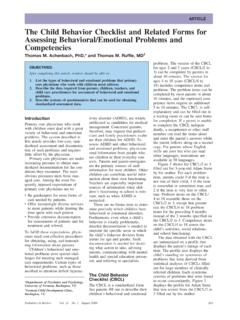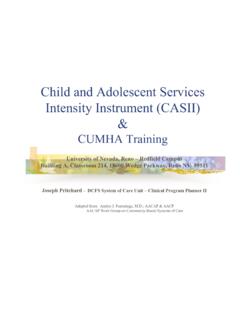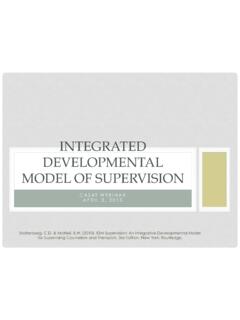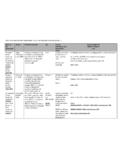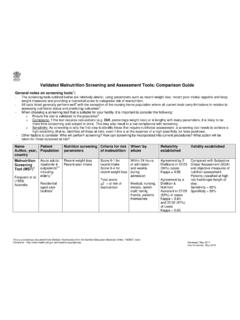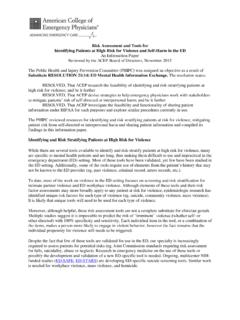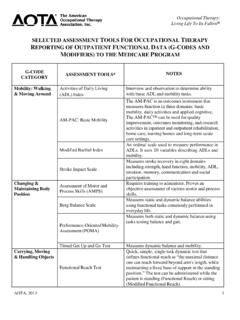Transcription of Child and Adolescent Screening and Assessment Tools
1 Child and Adolescent Screening and Assessment ToolsRandall Stiles, of NevadaDivision of Child and Family ServicesThe views, opinions, and content expressed in this presentation do not necessarily reflect the views, opinions, or policies of the Center for Mental Health Services (CMHS), the Substance Abuse and Mental Health Services Administration (SAMHSA), or the Department of Health and Human Services (HHS).Purpose of Training Review four Child / Adolescent Screening / Assessment Tools : Achenbach Child Behavior Checklist (CBCL) Child and Adolescent Needs and Strengths (CANS) Children s Uniform Mental Health Assessment (CUMHA) Child and Adolescent Services Intensity Instrument (CASII)Questions to address How do I decide which tool to use? When do I administer the tool ? How are they administered and scored? What do the scores tell me?
2 Child Behavior Checklist (CBCL) The CBCL is one of a family of Screening Tools developed by Thomas M. Achenbach starting in the 1960 s. Related forms include the Teacher s Report Form (TRF), and the Youth Self-Report (YSR) The CBCL and TRF can be used for children 6-18 years of age. The YSR can be used with youth 11-18 years of age. Preschool versions include the Child Behavior Checklist for Ages 1 -5 and the Caregiver-Teacher Report Form for Ages 1 -5. 3,500 research articles have studied the CBCL and related measures in 50 to use the CBCLA dministration of the CBCL The CBCL can be used as a general Screening tool whenever there is a suspicion of an emotional or behavioral problem with a Child 6-18 years of age. The CBCL must be completed by a parent/caretaker who knows the Child s day-to-day functioning well. The CBCL form is self-explanatory and includes biographical and general functioning questions as well as 113 statements that are rated as not true ( score 0), somewhat/sometimes true (score 1), or very true/often true (score 2).
3 Completion time is 15-20 minutes. Raters may take the form home to complete and return. The form is available in Spanish and over 50 other languagesHow is the CBCL scored? The CBCL is computer scored. Forms and computer scoring materials are available at The preschool version of the CBCL has a hand-scoring optionWhat does the CBCL tell me? The CBCL generates 8 Syndrome Scale Scores: Anxious/Depressed Withdrawn/Depressed Somatic Complaints Social Problems Thought Problems Attention Problems Rule-Breaking Behavior Aggressive BehaviorWhat does the CBCL tell me(cont.)? There are also three summary scores: Internalizing Problems (summarizing the Anxious/Depressed, Withdrawn/Depressed, and Somatic Complaints scores) Externalizing Problems (summarizing the Rule-Breaking Behavior and Aggressive Behavior scores) Total Problems score (summarizing all 8 syndrome scale scores There is also an Other Problems list, which lists specific problems that may be of clinical interest based on individual questions (ex.))
4 Overeating, sleep problems)What does the CBCL tell me (cont.)? There are 6 DSM-Oriented Scales scores which are consistent with specific DSM-5 diagnoses: Depressive Problems Anxiety Problems Somatic Problems Attention Deficit Oppositional Defiant Problems Conduct ProblemsWhat does the CBCL tell me (cont.)? There are 3 Competence Scale Scores which rate general functioning in these areas: Activities Social SchoolWhat does the CBCL tell me (cont.)? There are three 2007 Scale Scores: Sluggish Cognitive Tempo ( daydreaming, confusion) Obsessive-Compulsive Problems Stress Problems Finally, there is a Critical Items list that identifies specific items which may be of immediate clinical interest (harms self, hears things, sets fires)What does the CBCL tell me (cont.)? Each scale score is interpreted based on the T Score and Percentile score Percentile scores below the 95thpercentile (approximate t score of 65 and below) are considered to be in the normal range.
5 Percentile scores between the 95thand the 98thpercentile (approximate t scores of 65 to70) are considered to be in the borderline range. Percentile scores above the 98thpercentile (approximate t score of 70 and ) are considered to be in the clinical range. These guidelines are flexible based on the severity of the problem. Since CBCL responses are based on frequency (not true, somewhat/sometimes true, and very often/often true) rather than severity, problem scores approaching clinical significance should be further investigated for severity to determine service measures The Youth Self-Report (YSR) is used for youth 11-18 years of age. On this measure the Youth rate their own behavior. Questions are similar to the CBCL. Clinical scales are the same as the CBCL except that the 2007 Scales add PTSD and Positive Qualities scalesCBCL-related measures The Teacher Report Form (TRF)is also used for 6-18 year-old children but is completed by teachers.
6 The questions are similar, with added academic questions. Clinical scales are identical except that the Competence Scales are replaced by Adaptive Functioning Scales, and include: Academic Performance Working Hard Behaving Learning HappyCBCL-related measures (Cont.) The Child Behavior Checklist for Ages 1 -5 includes 100 preschool-relevant questions as well as a Language Development Survey for Ages 18-35 months that assesses language skills through general caretaker questions and a word list for caregivers to score the Child s vocabulary. Syndrome Scale Scores include the following scales: Emotionally Reactive Anxious/Depressed Somatic Complaints Withdrawn Sleep Problems Attention Problems Aggressive BehaviorCBCL-related measures (Cont.) The Child Behavior Checklist for Ages 1 -5 also has different DSM-Oriented Scales, including: Affective Problems Anxiety Problems Pervasive Developmental Problems Attention-Deficit Hyperactivity Problems Oppositional Defiant Problems There is a Language Development Survey that includes two scales: Average Length of Phrases Vocabulary ScoreCBCL-related measures (Cont.)
7 There is a Caregiver-Teacher Report Form for Ages 1 -5 that has the same scales as the Child Behavior Checklist for Ages 1 -5 except for the language development scales. Multiple CBCL-related scales can be collected on the same Child to confirm and/or clarify results. Using multiple CBCL-related scales has two major advantages: If results are similar across raters, results have greater reliability. If results differ across raters, there may either be different perceptions of the same behavior among raters OR the Child s behavior may differ in different situations and/or with different people, which is valuable clinical information that effects treatment planningNevada - Child and Adolescent Needs and Strengths (NV-CANS) The NV-CANS is the Nevada version of the CANS, developed in early 2016 in a workshop facilitated by John Lyons, the primary developer of the CANS.
8 Each organization using the CANS chooses which portion of CANS items to use to balance depth of Assessment with ease of administration. Nevada CANS workshop participants included private and public administrators, clinical managers and direct service providers. Initial training in the NV-CANS took place in December 2016 and rollout of the tool is in process. The NV-CANS is now used instead of the CAFAS in State of Nevada agencies The NV-CANS has a 0-6 year old version and a 7+ year old version. NV-CANS The NV-CANS has four uses: Assessing needs and strengths during the initial Assessment process Guiding treatment planning Facilitating outcome measurement Facilitating communication between service providers and continuity of care Assessment items are organized into 7 0-6 and 7+ versions have the same domains but include some different items within each domain.
9 Each item is rated on a 4-point scale or a yes/no scale Needs and strengths are generally rated based on the past 30 days Formal training and certification is required to administer the NV-CANS. Annual recertification is also required. You may contact Katherine Mayhew at training vouchers and access to the training website. You must be a QMHA or QMHP level to qualify for training. The tool itself is open-domain that is free for anyone who is trained and NV-CANS Domains: Potentially Traumatic/Adverse Childhood Experiences Behavioral/Emotional Needs Life Functioning Child /Youth Strengths Cultural Factors Risk Factors & Behaviors Caregiver Resources & Needs Each Domain has 10-15 Administration and ScoringThe domains which assess needs are generally scored as follow: Item scoring:RatingLevel of NeedAppropriateAction0No evidence of need No action needed 1 Significant history or possible need that is not interfering with functioning Watchful waiting/prevention/additional Assessment 2 Need interferes with functioning Action/intervention required 3 Need is dangerous or disabling Immediate action/Intensive action required NV-CANS Administration and ScoringThe Child Strengths Domain is generally scored as follows: Item scoring:RatingLevel of StrengthAppropriateAction0 Centerpiece strength Central to planning 1 Strength present Useful in planning 2 Identified strength Build or develop strength 3No strength identified Strength creation or identification may be indicated NV-CANS Administration and Scoring Each item has a general description of the item.
10 For example, the description of the Depression item in the Behavioral/Emotional Needs Domain is:DEPRESSION Symptoms included in this item are irritable or depressed mood, social withdrawal, sleep disturbances, weight/eating disturbances, and loss of motivation, interest or pleasure in daily activities. This dimension can be used to rate symptoms of the Depressive Disorders as specified in DSM-5. NV-CANS Administration and Scoring Each item also includes questions to consider. For the Depression item they are:Questions to Consider Is youth concerned about possible depression or chronic low mood and irritability? Has she/he withdrawn from normal activities? Does the youth seem lonely or not interested in others? NV-CANS Administration and Scoring Finally, each item has unique scoring criteria corresponding to the general guidelines shown on the previous slide.

